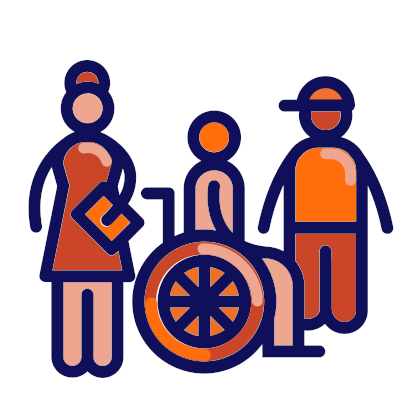Improving well-being at school

Since well-being has many facets, improving students’ well-being in schools requires a whole-school approach, involving both teachers and parents.
Schools should provide lessons focused on the responsible use of the Internet, the need to adopt a healthy lifestyle and how to prevent or cope with health problems, in collaboration with those involved, including health and social services, local authorities and civil society organisations.
Facts & figures
About 60% of school students report getting very tense when they study.[1]
Just over 60% of girls and 40% boys say they feel very anxious about doing tests at school, even when they are well prepared.[2]
Over 70% of parents say they would choose to send their children to a school with below-average exam results if students were happy there.[3]
What is well-being?
Well-being is the experience of health and happiness. It includes mental and physical health, physical and emotional safety, and a feeling of belonging, sense of purpose, achievement and success.
Well-being is a broad concept and covers a range of psychological and physical abilities. Five major types of well-being are said to be:
- Emotional well-being – the ability to be resilient, manage one’s emotions and generate emotions that lead to good feelings
- Physical well-being – the ability to improve the functioning of one’s body through healthy eating and good exercise habits
- Social well-being – the ability to communicate, develop meaningful relationships with others and create one’s own emotional support network
- Workplace well-being – the ability to pursue one’s own interests, beliefs and values in order to gain meaning and happiness in life and professional enrichment
- Societal well-being – the ability to participate in an active community or culture.
Overall well-being depends on all these types of functioning to an extent.[4]
“Having meaning and purpose is integral to people’s sense of well-being. Well-being involves far more than happiness, and accomplishments go far beyond test success.”[5]
Why is well-being important at school?
Well-being is important at school because schools have an essential role to play in supporting students to make healthy lifestyle choices and understand the effects of their choices on their health and well-being. Childhood and adolescence is a critical period in the development of long-term attitudes towards personal well-being and lifestyle choices. The social and emotional skills, knowledge and behaviours that young people learn in the classroom help them build resilience and set the pattern for how they will manage their physical and mental health throughout their lives.
Schools are able to provide students with reliable information and deepen their understanding of the choices they face. They are also able to provide students with the intellectual skills required to reflect critically on these choices and on the influences that society brings to bear on them, including through peer pressure, advertising, social media and family and cultural values.
There is a direct link between well-being and academic achievement and vice versa, i.e. well-being is a crucial prerequisite for achievement and achievement is essential for well-being. Physical activity is associated with improved learning and the ability to concentrate. Strong, supportive relationships provide students with the emotional resources to step out of their intellectual ‘comfort zone’ and explore new ideas and ways of thinking, which is fundamental to educational achievement.
Well-being is also important for developing important democratic competences. Positive emotions are associated with the development of flexibility and adaptability, openness to other cultures and beliefs, self-efficacy and tolerance of ambiguity, all of which lie at the heart of the Council of Europe Reference Framework of Competences for Democratic Culture.
What are the challenges?
One of the challenges of trying to promote young people’s well-being in school is the multi-faceted nature of well-being. There are a number of different types of well-being, all of which need to be promoted to some extent to create an overall sense of well-being in a person. So, it is not possible to improve students’ well-being at school through single interventions or activities. Rather it requires the development of a ‘culture’ of well-being throughout the whole school and the active involvement of the whole staff, teaching and non-teaching, which can be difficult to achieve.
The promotion of well-being may sometimes appear to conflict with other school priorities, such as academic standards. Unreasonably high expectations, a regime of constant testing or an over-emphasis on the importance of academic performance may actually undermine student well-being.
In many cases schools do not have the freedom to make the changes to school life which might most benefit student well-being. They may have little control, for example, over formal examinations and tests, the content of curricula, the length of the school day or the physical school environment.
Nor have schools control over the many out-of-school influences on student well-being. What happens in the home and the family, local communities or social media can have as much, if not more, influence on student well-being as anything in school.
Finally, developing a sense of well-being in students is made all the more difficult when school staff themselves do not have a positive sense of well-being. Well-being at work is strongly related to stress. Stress at work is related to workload, quality of professional relationships, level of autonomy, clarity about one’s role, availability of support and the opportunity to be involved in changes which affect one’s professional life. High levels of stress can lead to demotivation, lack of job satisfaction and poor physical and mental health, which has a knock-on effect on students’ own well-being.
How can schools get active?
Addressing student well-being at school begins with helping students feel they are each known and valued as an individual in her or his own right, and that school life has a meaning and purpose for them. This can be achieved in a variety of small ways, the cumulative effect of which can have a very powerful influence on students’ sense of well-being. These include:
- providing opportunities for all members of the school community to participate in meaningful decision-making in school, e.g. through consultations, opinion surveys, referenda, electing class representatives, student parliaments, focus groups, in-class feedback on learning activities, and an element of student choice in relation to topics taught and teaching methods used;
- developing a welcoming environment where everyone at school can feel supported and safe through access to meaningful activities, e.g. clubs, societies, interest groups and associations dealing with issues of concern to young people, including health;
- taking steps to reduce the anxiety students feel about examinations and testing through the introduction of less stressful forms of assessment, e.g. formative assessment, peer assessment and involving students in the identification of their own assessment needs;
- using teaching methods that contribute to a positive classroom climate and well-being, e.g. cooperative learning, student-centred methods, self-organised time, outdoor activities;
- finding curriculum opportunities to talk about well-being issues with students, e.g. healthy eating, exercise, substance abuse, positive relationships;
- integrating democratic citizenship and education for intercultural understanding into different school subjects and extra-curricular activities, e.g. openness to other cultures in Religious Education, knowledge and critical understanding of human rights in Social Science, empathy in Literature;
- introducing student-led forms of conflict management and approaches to bullying and harassment, e.g. peer mediation, restorative justice;
- improving the physical environment of the school to make it more student-friendly, e.g. new furniture and fittings, carpeted areas, appropriate colour schemes, safe toilet areas, recreational areas;
- encouraging healthier eating by providing healthy options in the school canteen, e.g. avoiding high amounts of sugar, saturated fats and salt;
- working with parents to enhance students’ achievement and sense of purpose in school, e.g. on healthy food, safe internet use and home-school communications.
Individual initiatives like these can be brought together at the whole-school level through a policy development process which ‘mainstreams’ well-being as a school issue. This means giving attention to the potential effects of new policies on individual well-being - of students, teachers and others. Addressing student well-being at school always goes hand in hand with action to protect the health and well-being of teachers and other staff at school.
[1] OECD (2017). PISA 2015 Results (Volume III), p.40. Students’ Well-Being. Paris, France: OECD Publishing.
[3] Cowburn & Blow, ‘Wise up - Prioritising wellbeing in schools’
[4] Psychology Today, January 2019.
[5] Hargreaves & Shirley (2018), ‘Well-being and Success. Opposites that need to attract’.
 Resources on Improving well-being at school
Resources on Improving well-being at school
 Related schools projects
Related schools projects
Address: Žemdirbių g. 15, Velžio k
Country: Lietuva/Lithuania
Project: Prosocial Week
 Working language during the project:
Working language during the project:
- Lithuanian,
- English
 Themes of the Council of Europe project “FREE to SPEAK, SAFE to LEARN - Democratic Schools for All” covered:
Themes of the Council of Europe project “FREE to SPEAK, SAFE to LEARN - Democratic Schools for All” covered:
- Preventing violence and bullying
- Tackling discrimination
- Improving well-being at school
 Competences from the Reference Framework of Competences for Democratic Culture (CDC) addressed and where / how they were integrated:
Competences from the Reference Framework of Competences for Democratic Culture (CDC) addressed and where / how they were integrated:
- Openness to cultural otherness and to other beliefs, world views and practices
Discussions, Letters to Parents, Multimedia Materials, Posters, Postcards, Art activities, Wall of thoughts, Power of a smile, Mindfulness activities, Programme RESCUR Surfing The Waves. A Resilience Curriculum for Early Years and Primary Schools (Publisher: Centre for Resilience and Socio-Emotional Health, University of Malta). - Tolerance of ambiguity
Tolerance Cloud, What Can we Learn from the Box of Crayons, Multimedia Materials, Art activities, Wall of thoughts, Map of feelings, Mindfulness activities, Programme RESCUR Surfing The Waves (A Resilience Curriculum for Early Years and Primary Schools, publisher: Centre for Resilience and Socio-Emotional Health, University of Malta). - Co-operation skills
Discussions, Karaoke, Posters, Postcards, Diary of Thankfulness, Art activities, Wall of Thoughts, Exhibition, Mindfulness activities, Programme RESCUR Surfing The Waves (A Resilience Curriculum for Early Years and Primary Schools, publisher: Centre for Resilience and Socio-Emotional Health, University of Malta).
 Target group age range:
Target group age range:
- 5 - 11
- 11 - 15
 Level of education:
Level of education:
- Lower secondary education
Short description of the project:
The Project/Prosocial week is based on the Charter of prosocial values. The goal of education is not only the transmission of notions, but the growth of the individual by adopting values such as peace, solidarity, tolerance, respect, equity, cooperation, empathy, emotions, freedom, and citizenship. It is the foundation of the civil society and both students and teachers are representatives of their adherence to those values.
Year 2020/2021 Prosocial Week consisted of a set of activities (Shhh for the Shoes, Self-esteem Sunglasses, Nice Dice, Team Building Tower) triggering creativity in everyday classroom. Creativity allows self-discovery, as well as the opportunity to share a hidden side of ourselves. It reduces stress and anxiety. That is why children are more eager to learn through games and fun activities that engage them sharing their ideas and experiences. E.g. “Shhh for the Shoes”: children form a circle and tell their experiences, feelings, everyday life joys or problems using their shoes as main characters. “Nice Dice”: students throw a dice to each other and tell an exact amount of positive words or encouraging phrases. While communicating, cooperating and collaborating children had a possibility to talk about empathy, bullying and respect. They had a chance to (re)connect with friends and peers and find more confidence in themselves. Eventually, social values were established and strengthened.
Teachers are committed to:
- helping anyone in need, without discrimination for origin, ability, sex, social condition, age;
- recognizing access to rights and opportunities for all individuals;
- understanding the other and oneself through the other, by overcoming the barriers of verbal communication and openness towards others;
- showing a basis for personal and other rights, freedom of expression, thought and being;
- using education as a tool for understanding the world and for realizing potential and talents.
Students are committed to:
- listening to others and giving them importance;
- engaging in helping anyone in need, without making distinctions;
- showing diversity as something that enriches us and not as a threat to us;
- remembering that everyone should have the same possibilities and exercising the same rights; understanding that equity and fairness are the values behind the commitment to overcoming physical and social barriers;
- supporting others without judging their difficulty;
- cooperating and collaborating in mixed groups from classes;
- being able to put themselves in the shoes of the other trying to understand what s/he is experiencing and what emotions s/he feels;
- being free and allowing everyone to express themselves, to have their own thoughts and be themselves without being judged.
 Aims/objectives
Aims/objectives
Will help the school to reduce the incidents of bullying and/or social exclusion.
 Expected results/outcomes
Expected results/outcomes
- will bring a real change in the way the children learn to coexist in a better way;
- will have an impact also at the social level, paving the way for a peaceful and inclusive society;
- will increase students’ self-confidence by changing their negative self-statements to positive self-statements;
- will promote self-respect and validation, and respect for others;
- will promote discussion of many aspects of personal, social and emotional development;
- will open up a class and connect with each other (bonding throughout the year);
- will talk more about bullying in a fun way;
- will reach a better cooperation.
 Changes
Changes
Students and teachers respect each other more and are able to understand equality and fairness better; moreover, they are flexible and responsible.
 Challenges you faced
Challenges you faced
 Time-frame of the project:
Time-frame of the project:
Throughout every school year, in addition to a special Prosocial Week in October/November and extra-curriculum activities for 5th graders (age range 10-12, Programme RESCUR Surfing The Waves. A Resilience Curriculum for Early Years and Primary Schools)
 Council of Europe materials on citizenship and human rights education used while preparing or implementing your practice:
Council of Europe materials on citizenship and human rights education used while preparing or implementing your practice:
- Reference Framework of Competences for Democratic Culture
- Living Democracy - manuals for teachers
- All Different – All Equal
- Mirrors
- Multimedia Material (ex. video “Beat Bullying”, series of cartoons “Democracy and Human Rights at School”, video “Corporal punishment at school: how two parents decided to change things”)







